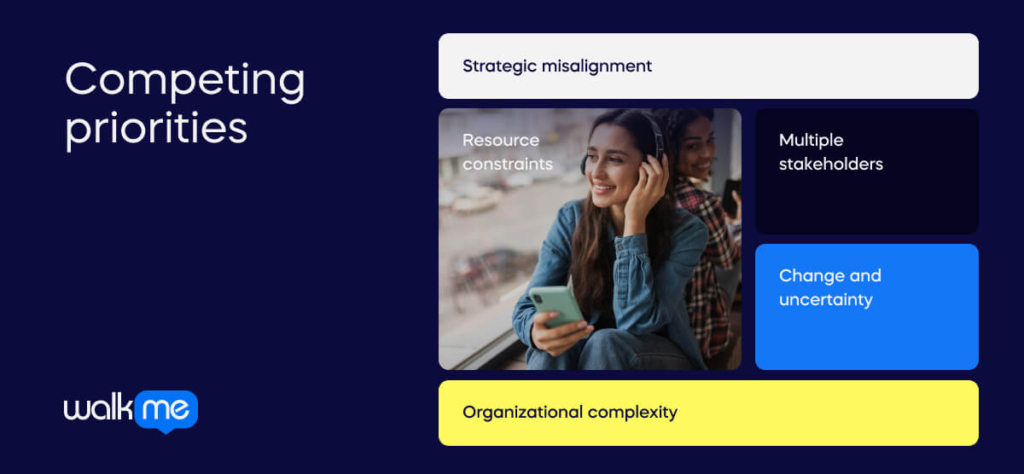In a business context, competing priorities are tasks, projects, or goals that demand attention and resources at the same time but don’t align with each other.
These various tasks vie for the same limited resources— time, human resources, financial investment, or managerial attention.
They may all be important to you, but given resource limitations, it becomes challenging to progress at the same pace or give equal attention to them.
Dealing with competing priorities is a critical element of effective change management. In fact, competing priorities are considered a constant challenge in any business setting.
This article reviews everything you need to know about competing priorities. From understanding and identifying them to strategies for dealing with them.
By the time you’re done reading, you’ll know the true impact of competing priorities in business and how to systematically overcome this recurring obstacle.
Understanding competing priorities

A byproduct of silo mentality, competing priorities can seriously impact decision-making within your organization.
On the positive side, they can promote critical thinking, compelling leaders to make strategic choices about resource allocation.
However, they can also lead to decision paralysis if there’s a lack of clarity or agreement on which priorities should take precedence.
These competing priorities can cause stress, confusion, and low morale among team members who may feel torn between projects or tasks.
They can also slow down progress on key initiatives and negatively impact business performance if not managed effectively. Gartner carried out research on the impact of competing priorities on the buying process in 2022. They found that 78% of CEOs reported significant or moderate delays caused by competing priorities.
Competing priorities can arise from various sources within your organization. Here are some of the most common:
Strategic misalignment
If business strategy is not aligned across different levels or departments, it can lead to conflicting priorities.
Resource constraints
Limited resources, be it time, staff, or budget, can often cause priorities to compete against each other.
Multiple stakeholders
Multiple stakeholders’ different needs and expectations can result in competing priorities.
Change and uncertainty
In periods of change or uncertainty, new and urgent priorities can emerge that compete with ongoing initiatives.
Organizational complexity
Larger or more complex organizations may naturally have more areas of focus, leading to more instances of competing priorities.
Understanding how to navigate these competing priorities is crucial for leaders and employees. That said, your role as a change leader is to do everything you can to support employees in balancing priorities.
The role of business leaders in handling competing priorities

When it comes to managing competing priorities, your job as a business leader is threefold:
- Identifying
- Strategizing
- Communicating
The first step in handling competing priorities is recognizing and identifying them.
You should regularly review the goals and projects in your purview and assess where potential conflicts might exist.
This process might involve examining each project’s objectives, resource requirements, timelines, and potential outcomes.
It’s also beneficial to consider external factors such as market conditions, customer expectations, or regulatory changes that could impact priorities.
Over time you’ll develop a keen sense of awareness to understand the dynamics within your team and wider organization to identify potential conflicts in their early stages.
Once you’ve identified competing priorities you need to strategize on how to get them all aligned.
This means making decisions about which tasks to prioritize and determining how to allocate resources effectively to achieve your organizational objectives.
Strategic planning may require you to make tough decisions, often requiring trade-offs.
For example, you might have to delay certain projects to focus on ones that align more closely with your organization’s strategic objectives or have a higher potential ROI.
Alternatively, you might have to redistribute resources between projects to ensure each has the necessary support.
Once decisions have been made about how to address competing priorities, you need to communicate these decisions to your teams, stakeholders, and other relevant parties within your organization.
Communication should be clear, concise, and transparent, providing the rationale behind decisions and outlining what the implications are for each team and project.
This process should also involve listening and responding to concerns or feedback, which can foster understanding and buy-in, reducing resistance to change.
Regular updates ensure everyone remains aligned with the chosen path. By maintaining open lines of communication, you can help to ensure that everyone understands their role in fulfilling the organization’s objectives, reducing the potential for confusion or conflict.
The role of HR leaders in handling competing priorities
HR leaders also play a crucial role in supporting employees as they navigate through competing priorities.
You can do this by providing employee training and resources on time management, prioritization, and effective work techniques.
You can also promote a work environment that allows flexibility, supporting employees in balancing their tasks according to shifting priorities.
Make employee well-being a key focus, with HR ensuring that workloads remain manageable and that employees feel supported in their roles.
HR leaders also need to consider implementing policies that address the challenges of competing priorities.
This might involve policies that regulate workload allocation, establish clear project roles and responsibilities, or set guidelines for collaboration and decision-making in the face of conflicting priorities.
HR policies should also emphasize open communication, encouraging employees to voice concerns and suggestions about workload and priority management.
Finally, HR leaders should try to create a culture that effectively manages competing priorities.
You can achieve this by rewarding effective priority management and promoting the value of strategic focus and adaptability.
HR leaders should also cultivate a culture of continuous learning, where employees and teams are encouraged to learn from past experiences and improve their methods for managing priorities.
The role of change managers in handling competing priorities
Change managers must have a deep understanding of the dynamics of change and how it can create or exacerbate competing priorities.
By understanding these dynamics, you can anticipate potential conflicts, make informed decisions, and guide teams and stakeholders through the process more effectively.
Amidst competing priorities, leading the change management process can be complex.
Change managers need to steer the organization through the change while managing conflicts and keeping everyone focused on the end goal.
This might involve making difficult decisions about what changes take precedence, how to allocate resources, and how to mitigate potential negative impacts.
In the face of competing priorities, resilience and flexibility become vital traits for an organization. Change managers play a key role in building these traits.
They can help to create a resilient organization by promoting a growth mindset, encouraging adaptability, and equipping employees with the skills to manage change and conflict.
Strategies for managing competing priorities

If you’re looking for more practical advice on how to handle competing priorities, we’ve created a list of some of our favorite tools and techniques.
On top of helping you manage competing priorities, many of these tools and techniques will have a generally positive impact on your productivity and organization.
Eisenhower matrix
Apparently devised by 34th U.S. President Dwight D. Eisenhower, the Eisenhower Matrix is a simple yet effective tool for prioritizing tasks by dividing them into four categories based on their urgency and importance.
These categories are:
- Urgent and important (do first),
- Important but not urgent (schedule)
- Urgent but not important (delegate)
- Neither urgent nor important (eliminate)
The main benefit of this technique is its simplicity and flexibility. It can be used for personal productivity, project management, and strategic planning.
It helps clarify what tasks require immediate attention and which can be scheduled, delegated, or eliminated, making it easier to manage workloads and use resources more effectively.
MoSCoW method
The MoSCoW method is a prioritization technique often used in project management and business analysis.
Similar to the Eisenhower matrix, the MoSCoW method involves categorizing tasks into four groups:
- Must have
- Should have
- Could have
- Won’t have
This method is particularly useful for managing scope and ensuring that all essential tasks (Must) are completed first, followed by important but not critical tasks (Should), desirable tasks (Could), and those that are agreed to be out of scope for the current timeline (Won’t).
It’s a flexible, adaptable method that helps maintain focus on what’s truly necessary for a project’s success.
Kano model
The Kano Model is a theory of product development and customer satisfaction that can be used to prioritize features.
It classifies features into five categories:
- Must-Be
- One-Dimensional
- Attractive
- Indifferent
- Reverse
The Kano model helps understand which features will satisfy customers and which may not.
It’s a powerful tool for making strategic decisions about product development, helping teams prioritize features that can deliver the most customer value.
Digital project management tools

Digital tools like Trello, Asana, and Jira offer powerful platforms for organizing and prioritizing tasks.
These tools can significantly enhance productivity by helping teams organize work, manage tasks, and prioritize effectively.
They also provide clear visibility into project progress, which aids in keeping everyone aligned and focused.
The best tool for you will be a subjective choice based on your personal preferences, and there are many more options out there than the three we’ve listed.
That said, here’s a quick summary of each:
Trello
Trello is a highly visual tool that uses a system of boards, lists, and cards to represent projects, tasks, and subtasks.
It’s particularly good for collaborative projects and teams, offering a clear view of what’s being worked on, who’s doing it, and how things are progressing.
Asana
Asana is a feature-rich project management tool offering task prioritization, timelines, and progress tracking.
It’s great for larger projects or ongoing work where keeping track of multiple tasks and deadlines is important.
Jira
Jira is commonly used for software development projects, but it’s versatile enough to manage different projects.
It offers tools for creating user stories, planning sprints, and distributing tasks across the team.
Combat competing priorities with organizational cohesion
Managing competing priorities is fundamental to business leadership, HR strategy, and change management.
The role of leaders in managing these competing priorities cannot be understated.
Business leaders need to adeptly recognize and strategically plan to align competing priorities.
HR leaders must support employees in this process and cultivate a culture that can effectively manage priorities
Change managers need to lead the change process amidst these conflicts, building organizational resilience.
The bottom line is this:
Competing priorities are a result of a lack of cohesion within your organization. Developing more cohesion between different departments directly combats competing priorities.
And that’s not the only benefit. 2023 research from Mckinsey shows that firms with a high level of organizational cohesion are 2.3 times more likely to be in the top quartile of healthy and high-performing organizations.
The business landscape is ever-evolving, and with it, so are the priorities. It’s, therefore, essential for leaders to continuously improve their approaches to managing these priorities.
Adapting to changes and being open to improvements helps navigate the challenges of competing priorities and promotes a culture of agility and resilience.
This adaptability will enable your organization to navigate the complexities of competing priorities effectively, ensuring your continued success in business endeavors.

